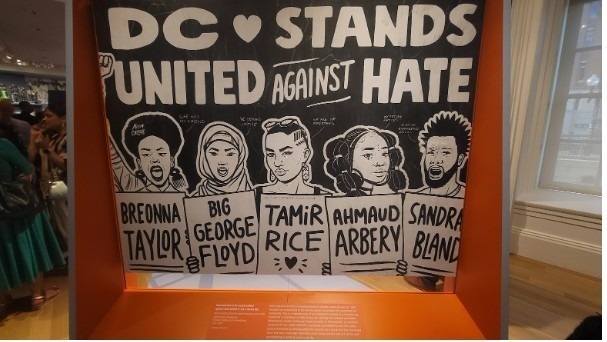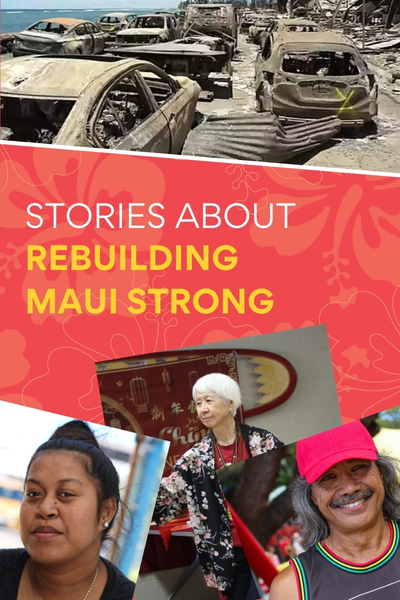By Jessica Xiao, AsAmNews Contributor
“There is a history of Asian Americans in the city. We hope most people will be like, let me rethink how I see the city.” — Sojin Kim, Curator of Sightlines: Chinatown and Beyond
Reproduction of a “DC Stands United Against Hate” mural on H Street in Chinatown by DC-based artist of Indonesian descent, MISS CHELOVE, in the Smithsonian Asian Pacific American Center’s Sightlines: Chinatown and Beyond Exhibit. Photo by Jessica Xiao.
The Takeaways:
- Exhibit Overview: “Sightlines: Chinatown and Beyond” by the Smithsonian Asian Pacific American Center (APAC) captures the essence of DC’s Chinatown through memorabilia and art, enhanced by sound.
- Community Focus: The exhibit highlights the contributions of Asian Americans and their neighbors, emphasizing community involvement and input in the curation process.
- Historical Context: The exhibit acknowledges the impact of developments like the convention center (2003) and the sports stadium (1997) on the Chinatown community.
- Cultural Integration: It honors the diverse cultural influences in Chinatown, and other community spaces in DC, including the significant Black community, and showcases symbols like trophies from the Simba Dojang school of Tae Kwon Do.
- Future Plans: APAC is planning another exhibit at the National Museum of American History focusing on Filipino American farm workers in Stockton, California, set to open in late fall 2025.
The Details:
WASHINGTON, DC — If there’s one takeaway from Sightlines: Chinatown and Beyond, the latest exhibit by the Smithsonian Asian Pacific American Center (APAC), it’s that just a few objects can capture the sense of place, geography, and culture of DC’s Chinatown neighborhood, and serve as an invitation to explore more deeply.
Sightlines offers a snapshot of DC’s Chinatown through the display of memorabilia and art, enhanced by the sense of sound.
It tells the story of not only the community’s Chinese Americans but also their neighbors who shaped the community despite developments like the convention center in 2003 and the sports and entertainment stadium built in 1997.
The exhibit, featuring three themes: “Making Place,” “Transforming Tradition,” and “Visualizing Identity,” is housed in the Smithsonian American Art Museum, a building that overlooks Chinatown.
Designing the Exhibit With Communities at Its Center
All the right elements were in the right place at the right time, according to Rick H. Lee, Director of External Affairs and Strategic Partnerships at the Smithsonian APAC, who called the exhibit “lightning in a bottle.”
Sojin Kim had already been working on an inaugural DC historical context statement focusing on Chinese and Korean American history in Washington, DC. When an exhibit space opened up at the Smithsonian American Art Museum, Yao-Fen You, APAC’s acting director, invited Kim to curate some of the findings of the context statement into an exhibition
She grew up in DC, studied and sharpened her curatorial skills in Los Angeles at the Japanese American National Museum, and returned to DC as a curator at the Smithsonian Center for Folklife and Cultural Heritage.
She recalls realizing the depth of her relationship with DC when she went to the DC Office of Public Records and Archives to collect her father’s death certificate in 2019. “They asked, were you born here? I said, ‘yes, I was born here.’ And so I left the office of records with both my birth certificate and my father’s death certificate.”
This moment gave her some degree of confidence as a community member developing a community exhibit, which showed in the curation. “Kudos to Sojin for all her connections with community partners that had so much interest already. She has the networks and knows where to find certain things that could be included as objects,” said Rick Lee.
Her background in community history projects also ensured her team designed a curation process that was intentionally shaped for meaningful community input and participation to ensure accurate representation: “We wanted to make sure that we were telling stories [community members] were comfortable with us telling and telling them using language that they were comfortable with us using. We vetted things; we sat with people, we went through various iterations of the design, and we showed them copies of the labels,” she said.
Top: Robert Wood, a long-time member of the DC martial arts community, at the opening event of the Sightlines exhibit. Bottom: Robert Wood shared his stories and objects with the curation team, including this photo of Wood and team members, featured displayed in the exhibit. He recalls competing in a kung-fu competition in Taiwan in 1978. Photos by Jessica Xiao.
“ Whether or not it’s been 100 percent successful, we’ve tried to do an exhibition that draws upon community knowledge and community resources in a thoughtful and consultative way.”
It took about two years from concept to execution, said Mia Owens, curatorial assistant on the exhibit and also a collaborator on the DC historical context statement on Asian Americans.
And most importantly, Asian residents were not painted in isolation, but as active neighbors of the culturally influential and large Black community that inspired DC’s former nickname as “Chocolate City.” In the “Transforming Tradition” section of the exhibit, rows of trophies from the Simba Dojang school of Tae Kwon Do are displayed as one symbol that uplifts the martial arts styles Asian immigrants from various countries brought to the city and the Black practitioners who sustained and evolved the practices.
“Oftentimes in Chinatown, only the Chinese community gets recognized. We wanted to honor the full scope of who is here,” said Owens.
The Challenge of Choosing Objects, Choosing Stories
Harry Chow, DC Chinatown community archivist and photographer who contributed to the Sightlines exhibit posing in front of a section that features some of his photos and memorabilia on opening day (September 2024). Photo by Jessica Xiao.
To reflect decades of history in the space of one room is an impossible challenge that APAC’s curatorial team for the exhibit took on with care and pragmatism. “There’s so much richness and nuance in the AAPI history in DC that we can’t capture on these walls,“ said Mia Owens, curatorial assistant at Sightlines, and said they were often confronted with “killing our darlings” in the curation process.
The original project proposal included seven narratives or “protagonists,” said Sojin Kim, before the exhibit was whittled down to three themes. From developing the storylines to choosing and maintaining objects in the exhibit, to the design of how the objects in physical space impact the visitors, the exhibit-making process is iterative, Kim added.
For the stories that they couldn’t include in the exhibit space, Adriel Luis, APAC’s curator of Digital and Emerging Practice, and the curation team created a digital companion to the exhibition.
The Challenges and Complexities of Honoring AAPI History
Although Smithsonian APAC doesn’t have a physical exhibition space, they are tasked with bringing AAPI perspectives into Smithsonian museums in a sustainable way and see their ability to collaborate across museums as a strength. They are currently planning a second exhibit at the National Museum of American History opening in late fall 2025, How Can You Forget Me: Filipino American Stories focuses on Filipino American farm workers in Stockton—a key agricultural hub in central California’s San Joaquin Delta region.
Members of Smithsonian Asian Pacific American Center team, curators, and community advisors at the opening event of the Sightlines exhibit. Photo by Matailong Du for the Smithsonian Asian Pacific American Center.
Instead of trying to meet an unrealistic but reasonable thirst for comprehensive all-encompassing exhibits of AAPIs, Sojin Kim says APAC has the flexibility to strategically surface AAPI contributions to American society:
“People have huge expectations because there hasn’t always been great coverage,” said Sojin Kim, “But it’s about hitting Asian American history, Pacific Islander history from different angles, from different vantages, within different types of disciplinary frameworks, within museums of focus in slightly different ways. So it’s not trying to tell everything all at once, which we should never be asked to do anyway.”
All of these efforts, says Sojin, including the DC Historical Context Statement, are different ways to build foundations and branches to make visible and honor DC’s Asian American population across audiences:
“It’s not a very visible history. It’s a small population, but it doesn’t mean that it doesn’t exist. And it doesn’t mean that it’s not important to know and actually try to see where Asian Americans fit into this landscape of the city because they have been here for a long time.”
The exhibit and additional programming around the exhibit run through November 30, 2025.
(Correction: An earlier version of this story misidentified a curator of this exhibition and her job title. We also misspelled Adriel Luis’ last name. We apologize for the errors)
AsAmNews is published by the non-profit, Asian American Media Inc.
We’re now on BlueSky. You can now keep up with the latest AAPI news there and on Instagram, TikTok, Facebook, YouTube and X.
We are supported by generous donations from our readers and by such charitable foundations as the Robert Wood Johnson Foundation.
You can make your tax-deductible donations here via credit card, debit card, Apple Pay, Google Pay, PayPal and Venmo. Stock donations and donations via DAFs are also welcomed.


